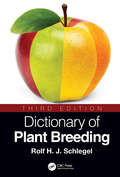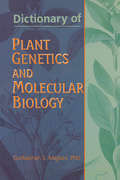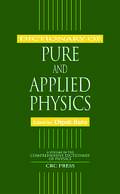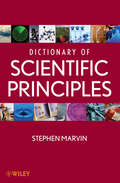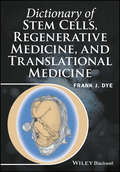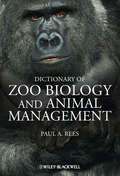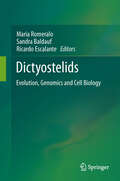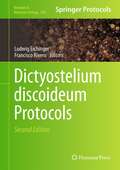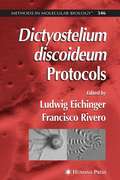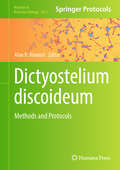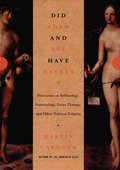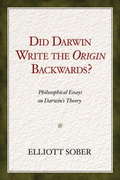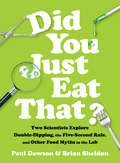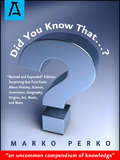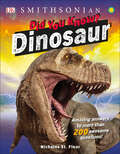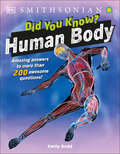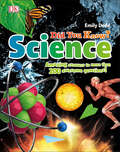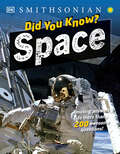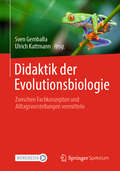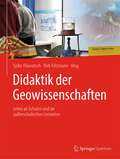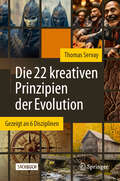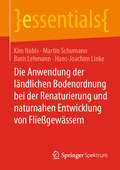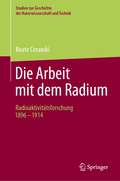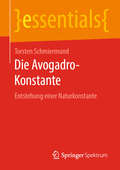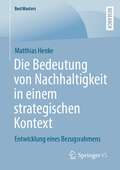- Table View
- List View
Dictionary of Plant Breeding
by Rolf H. SchlegelOne of the oldest scientific traditions, plant breeding began in Neolithic times with methods as simple as saving the seeds of desirable plants and sowing them later. It was not until the re-encounter with Mendel’s discoveries thousands of years later, the genetic basis of breeding was understood. Developments following have provided further insight into how genes acting alone or in concert with other genes and the environment, result in a particular phenotype. From Abaxial to Zymogram, the third edition of Dictionary of Plant Breeding contains clear and useful definitions of the terms associated with plant breeding and related scientific/technological disciplines. It defines jargon; provides helpful tables, examples, and breeding schemes; and includes a list of crop plants with salient details. Packed with data and organized to make that data easy to access, this revised and expanded reference provides comprehensive coverage of the latest discoveries in cytogenetics, molecular genetics, marker-assisted selection, experimental gene transfer, CRISPR technology, seed sciences, crop physiology, and genetically modified crops. Features: Provides a comprehensive list of technical terms used in plant breeding Explores the historical development of crop improvement Discusses applications of molecular genetics and biotechnology Includes numerous figures, drawings, tables, and schemes supplementing the glossary A complex subject, plant breeding draws from many scientific and technological disciplines, often making it difficult to know the precise meanings of many terms and to accurately interpret specific concepts. As in the previous editions, this dictionary unifies concepts by including the specific terms of plant breeding and terms that are adjusted from other disciplines. Drawing on Rolf Schlegel’s 50 years of experience, the book provides an encyclopedic list of commonly used technical terms that reflect the latest developments in the field.
Dictionary of Plant Genetics and Molecular Biology
by Gurbachan MiglaniIn the Dictionary of Plant Genetics and Molecular Biology, more than 3,500 technical terms from the fields of plant genetics and molecular biology are defined for students, teachers, and researchers in universities, institutes, and agricultural research stations. An excellent educational tool that will save you time and effort, this dictionary brings together into a single source the meaning and origin of terms from the fields of classical genetics, molecular genetics, mutagenesis, population genetics, statistics, plant biotechnology, evolutionary genetics, plant breeding, and plant biotechnology.Finding and understanding the precise meaning of many terms in genetics is crucial to understanding the foundation of the subject matter. For reasons of space, the glossaries provided at the end of most textbooks are highly inadequate. There is, then, dire need for a dictionary of terms in a single volume. You?ll appreciate the helpful approaches and features of Dictionary of Plant Genetics and Molecular Biology, including:no terms that are of limited use, very general, or self-explanatorycross references for effective access to the materials and economy of spacealternate names of terms, denoted with “Also referred to as . . .” or “Also known as . . .”multiple definitions for terms defined by different authors or for terms with different meanings in different contextsauthors who coined, described, or contributed toward further understanding of a term are listed and respective publications are included in the BibliographyAt last, there is compiled in a single volume the technical terms you need to know in order to understand plant genetics and molecular biology. As your knowledge grows, you?ll uncover even more terms that you need to understand. You?ll find yourself turning to this handy guide time and time again for help on all levels.
Dictionary of Pure and Applied Physics
by Dipak BasuClear, precise definitions of scientific terms are crucial to good scientific and technical writing-and to understanding the writings of others. Whether you are a physicist, engineer, mathematician, or technical writer, whether you work in a research, academic, or industrial setting, we all have the occasional need for comprehensible, working definitions of scientific terms. To meet that need, CRC Press proudly announces publication of the Dictionary of Pure and Applied Physics-the first published volume of CRC's Comprehensive Dictionary of Physics. Authored by eminent scientists from around the world, offers concise, authoritative definitions of more than 3,000 terms covering a range of pure and applied disciplines: acoustics biophysics communications electricity electronics geometrical optics low-temperature physics magnetism medical physics physical optics The editor has taken care to ensure each entry is as self-contained as possible, to include terms from the frontiers of technology, and to omit obsolete terms that can clutter a search. The result is a lucid, accessible, and convenient reference valuable to both the novice and the seasoned professional.
Dictionary of Scientific Principles
by Stephen MarvinDictionary of Scientific Principles presents a unique and timeless collection of (almost) all known rules or laws commonly called principles, identified throughout the history of scientific development, their definition, and use. Exploring a broad range of disciplines, the book first lists more than 2,000 principles organized in a standard alphabetical order, then provides a list of subject headings for which related principles are identified. A staple addition to every library, the dictionary will also be of interest to scientists and general readers.
Dictionary of Stem Cells, Regenerative Medicine, and Translational Medicine
by Frank J. DyeStem cells, regenerative medicine, and translational medicine, are all areas of burgeoning basic research and clinical application. This dictionary includes the fundamental terminology of each of these areas, the major discoveries and significant scientists that comprise the history and current development of the field, as well as a number of concepts. The vocabulary is presented within the broader lexicon of developmental biology and embryology, which provides context for these three fields. Topics covered range from stem cells (embryonic, adult, and iPSCs) to teratology. The inclusion of extensive cross-referencing of the terms will enable readers to broaden their understanding of them. The Dictionary of Stem Cells, Regenerative Medicine, and Translational Medicine will provide both the basic background terminology needed by pre-health professions/biology major undergraduate students and early-stage graduate students, as well as being a valuable reference for university professors, researchers and peers in related disciplines.
Dictionary of Zoo Biology and Animal Management
by Paul A. ReesThis dictionary is intended as a guide to the terminology used in a wide range of animal-related programmes of study including agriculture, animal care, animal management, animal production, animal welfare, veterinary nursing, wildlife conservation and zoo biology. In total it contains over 5,300 entries. It contains a wide range of terms used in the fields of veterinary science, physiology and zoology, as students whose primary interests are animal welfare or zoo biology also need to have some understanding of disease, how animal bodies function and how animals are classified. It also contains some legal terms, and reference to some legal cases, to help students understand how the protection, use and conservation of animals is regulated by the law. Some people, famous animals, literature and films have influenced the way we think about, and behave towards, animals. For this reason, the book includes references to important books about animals, famous animals who have starred in films or been the subject of scientific studies, along with short biographies of famous scientists and others who have studied animals or established conservation or animal welfare organisations.
Dictyostelids: Evolution, Genomics and Cell Biology
by Ricardo Escalante Sandra Baldauf Maria RomeraloSince their discovery in 1869, the dictyostelids have attracted the attention of scientists in a wide variety of fields. This interest has stemmed from their peculiar lifestyle and developmental properties, which were shaped by the evolutionary forces that generated multicellularity during eukaryotic evolution. More recently, the dictyostelids have gained attention due to the striking similarities found at the genomic, cellular and biochemical levels with human cells, which has propelled the species Dictyostelium discoideum to become a model system for biology and medicine in many laboratories. This book covers the latest advances in our knowledge of these extraordinary organisms with topics spanning from their evolutionary history, ecology and diversity to the recent discoveries regarding their cellular and molecular biology.
Dictyostelium discoideum Protocols
by Ludwig Eichinger Francisco RiveroDictyostelium discoideum is a well-establish eukaryotic model organism that offers unique advantages for studying fundamental cellular processes, including signal transduction, random and directed cell motility, cytokinesis, endocytosis and vesicle transport and development. Dictyostelium is also increasingly used for the investigation of human disease genes and the crosstalk between host and pathogen. The availability of the genome sequence at a mouse click together with a whole range of supporting information and resources along with a powerful armoury of molecular genetics techniques have considerably enhanced the experimental attractiveness of D. discoideum in recent years. The second edition of Dictyostelium discoideum Protocols incorporates the most recent developments in a number of fields. The book is divided into four parts. The first part provides an introduction to the amoebozoa and community resources. The second part presents large-scale analysis methods made possible by the completion of the Dictyostelium genome sequence. The third part is dedicated to molecular genetics techniques, cell biological, biochemical and biophysical methods. The chapters in the fourth part describe the use of Dictyostelium as a model system to study vesicle formation, trafficking and infection by bacterial pathogens. Written in the highly successful Methods in Molecular BiologyTM series format, chapters include introductions to their respective topics, lists of the necessary materials and reagents, step-by-step, readily reproducible laboratory protocols, and key tips on troubleshooting and avoiding known pitfalls. Authoritative and practical, Dictyostelium discoideum Protocols, Second Edition seeks to aid scientists in the application of innovating techniques to study a range of fundamental biological processes in this attractive model organism.
Dictyostelium discoideum Protocols
by Ludwig EichingerDictyostelium discoideum Protocols presents a comprehensive collection of cutting-edge molecular biological protocols for studying D. discoideum, with emphasis on its utility in the study of fundamental cellular processes including signal transduction, chemotaxis, cell motility, cytokinesis, phagocytosis, and aspects of development such as cell sorting, pattern formation, and cell type differentiation. Written by experts in the field, this important guide provides easy access to current methods and techniques for the study of D. discoideum. For the newcomer to the field, it offers a complete and inclusive introduction to this important model organism. The book is divided into four main parts, which include an introduction to the organism that provides integral community resources and genome-wide approaches; basic methods and available molecular genetic techniques for study of the organism; imaging and localization methods; and a discussion of D. discoideum, with emphasis on its unique advantages as a model system. This in-depth guide provides a complete introduction to and thorough handbook for the study of D. discoideum, including a discussion of the implications of the recently-completed Dictyostelium genome project in strengthening the position of D. discoideum as a model organism for studying fundamental cell processes and aspects of development. Researchers at all levels of experience will benefit from the presentations throughout of the most current, useful and innovative techniques for the study of D. discoideum from leading Dictyostelium scientists.
Dictyostelium discoideum: Methods and Protocols (Methods in Molecular Biology #2814)
by Alan R. KimmelThis volume discusses the latest advancements and techniques used to study Dictyostelium discoideum. The chapters in this book cover topics such as cytokinesis, membrane function and damage, and nutrient/bacterial processing; autophagy activation and function; protein localization, interaction, and activation; cell migration and contact guidance for quantification of cytoskeletal dynamics; and global mutational screening, transcriptome analyses, and proteomics that apply to all stages of the Dictyostelium life cycle and that may generalize to human disease models. Written in the highly successful Methods in Molecular Biology series format, chapters include introductions to their respective topics, lists of the necessary materials and reagents, step-by-step, readily reproducible laboratory protocols, and tips on troubleshooting and avoiding known pitfalls. Cutting-edge and comprehensive, Dictyostelium discoideum: Methods and Protocols is a valuable resource for all researchers who are interested in learning more about this important and developing field.
Did Adam and Eve Have Navels?: Debunking Pseudoscience
by Martin Gardner"[Gardner] zaps his targets with laserlike precision and wit."--Entertainment Weekly Martin Gardner is perhaps the wittiest, most devastating unmasker of scientific fraud and intellectual chicanery of our time. Here he muses on topics as diverse as numerology, New Age anthropology, and the late Senator Claiborne Pell's obsession with UFOs, as he mines Americans' seemingly inexhaustible appetite for bad science. Gardner's funny, brilliantly unsettling exposés of reflexology and urine therapy should be required reading for anyone interested in "alternative" medicine. In a world increasingly tilted toward superstition, Did Adam and Eve Have Navels? will give those of us who prize logic and common sense immense solace and inspiration. "Gardner is a national treasure...I wish [this] could be made compulsory reading in every high school--and in Congress."--Arthur C. Clarke "Nobody alive has done more than Gardner to spread the understanding and appreciation of mathematics, and to dispel superstition."-- The New Criterion, John Derbyshire
Did Darwin Write the Origin Backwards?
by Elliott SoberIs it accurate to label Darwin's theory "the theory of evolution by natural selection," given that the concept of common ancestry is at least as central to Darwin's theory? Did Darwin reject the idea that group selection causes characteristics to evolve that are good for the group though bad for the individual? How does Darwin's discussion of God in The Origin of Species square with the common view that he is the champion of methodological naturalism? These are just some of the intriguing questions raised in this volume of interconnected philosophical essays on Darwin. The author's approach is informed by modern issues in evolutionary biology, but is sensitive to the ways in which Darwin's outlook differed from that of many biologists today. The main topics that are the focus of the book--common ancestry, group selection, sex ratio, and naturalism--have rarely been discussed in their connection with Darwin in such penetrating detail. Author Professor Sober is the 2008 winner of the Prometheus Prize. This biennial award, established in 2006 through the American Philosophical Association, is designed "to honor a distinguished philosopher in recognition of his or her lifetime contribution to expanding the frontiers of research in philosophy and science." This insightful collection of essays will be of interest to philosophers, biologists, and laypersons seeking a deeper understanding of one of the most influential scientific theories ever propounded.
Did You Just Eat That?: Two Scientists Explore Double-dipping, The Five-second Rule, And Other Food Myths In The Lab
by Paul Dawson Brian SheldonIs the five-second rule legitimate? Are electric hand dryers really bacteria blowers? Am I spraying germs everywhere when I blow on my birthday cake? How gross is backwash? When it comes to food safety and germs, there are as many common questions as there are misconceptions. And yet there has never been a book that clearly examines the science behind these important issues—until now. In Did You Just Eat That? food scientists Paul Dawson and Brian Sheldon take readers into the lab to show, for example, how they determine the amount of bacteria that gets transferred by sharing utensils or how many microbes live on restaurant menus. The authors list their materials and methods (in case you want to replicate the experiments), guide us through their results, and offer in-depth explanations of good hygiene and microbiology. Written with candid humor and richly illustrated, this fascinating book will reveal surprising answers to the most frequently debated—and also the weirdest—questions about food and germs, sure to satisfy anyone who has ever wondered: should I really eat that?
Did You Know That…?: Surprising-But-True Facts About History, Science, Inventions, Geography, Origins, Art, Music, and More
by Marko PerkoDID YOU KNOW THAT...? : The "Revised and Expanded" Edition is an uncommon compendium of knowledge that will astound, demystify, edify, and debunk. It is a book of ambitious design that is both eminently informative and vastly entertaining. Assiduously researched, it will be the arbiter of disagreements and will stand cherished misconceptions right on their heads. It will also expose factoids, unmask present-day orthodoxy, identify misinformation, clarify the confusing, and present new information. Did You Know That...? is all you need to know...for knowledge is power!See: www.MarkoPerko.com
Did You Know? Dinosaurs (Why? Series)
by DKCould I have a pet dinosaur? Why did T. rex have such short arms? What can we learn from dinosaur poo?Explore the intriguing answers to more than 200 questions about dinosaurs in DK's newest dinosaur encyclopedia for kids.This children's book, ideal for ages 6-9, will help inquisitive minds find out the answers to all the dinosaur questions they may have, and some they hadn't thought of! Did dinosaurs sleep? Did they have feathers? Covering amazing ancient creatures, fantastic fossils, and the positively perplexing prehistoric world, Does a Dinosaur Roar? helps children get to grips with the gigantic topic that is dinosaurs. Bursting with up-to-date facts and discoveries, this visually stunning book is something that every young dinosaur enthusiast and fossil hunter will want to own.Get your child learning with this amazing dinosaur book, which is packed with fantastic facts for curious minds.
Did You Know? Human Body (Why? Series)
by DKDiscover the answers to more than 200 of the most jaw-dropping questions about the human bodyEver wonder what&’s happening inside your body right now? Young readers will love learning the answers to all their sensational and squeamish questions about what makes us human in this children&’s biology book, perfect for kids aged 6-9.Inside the pages of this mind-boggling human body factbook, you&’ll discover: • Five chapters covering body basics, parts of the body, how the body works, being healthy, and medical marvels • Question and answer format that makes topics easily digestible and intriguing • &‘Quick quiz&’ boxes that allow young readers to test their knowledge of the human body • Fun facts and detailed illustrations covering a large range of both common and bizarre biology topics A fantastic introduction to what&’s hiding under our skinThis human body encyclopedia for kids is packed with captivating facts for curious minds! What are bones made of? Why does sugar taste sweet? Why do our ears pop? Page after page, kids will uncover incredible answers to all the questions they&’ve ever had about their body, and some they haven&’t even thought of! Did You Know? Human Body cleverly combines charming illustrations with clear, jargon-free language, making it easy for kids to get to grips with the gigantic topic that is human biology. It&’s the ultimate children&’s encyclopedia for budding scientists who are fascinated by how our bodies work!More in the seriesThere&’s so much more to discover! Explore the answers to all the probing questions kids ask about their favorite animals in Did You Know? Animals. Learn the intriguing answers to more than 200 questions about dinosaurs in Did You Know? Dinosaurs.
Did You Know? Science (Why? Series)
by DKSatisfy your curious budding scientist with a book that explains the way we explain everything else. It all comes down to Science!Learn about a range of subjects that tell us about everything. From earth science and biology, to energy, physics, and astronomy. We give the answers to the questions kids aged 7-10 really want to know about in easy-to-follow question and answer format.This book focuses on the subjects that kids really want to know about and the questions they ask. Every question is answered with a detailed explanation, rich illustrations, and easy to understand text that will ease the curiosity of young minds. From earth science and biology to energy, physics, and astronomy. Did You Know? Science makes learning the science behind everyday matters easy to understand, fun, and engaging.Answers to over 200 questions about the living world, the human body, the material world, energy, forces, movement, and our planet. Described in colorful pages and in a fun question-and-answer format. Designed for ages 5-9 and organized into easy to understand bite-size nuggets of information.Fantastic Facts For Curious Minds!Did You Know? Science answers all the amazing questions children have about science, from how lights turn on and what makes cars go, to what makes the Earth look blue and how people move! This colorful and exciting book is full of awesome pictures and incredible facts about magnets, fossils, the human body, our planet, and much more!This is the ideal science encyclopedia to help your budding Einstein, as well as for parents who need to answer those tricky science questions sparked by curiosity. &“Where does light come from? Can I feel forces? What is my body made of?&”This amazing science book will answer interesting questions about:- The Living World- The Human Body- The Material World- Energy- Our Planet- Forces And MovementDid You Know? Science: Amazing Answers To More Than 200 Awesome Questions is part of the educational series Did You Know? Encyclopedias. Complete the collection and learn more about the world around you and the questions you ask, science, and space.
Did You Know? Space (Why? Series)
by DKThis fact-filled space ebook features amazing pictures from NASA and asks questions such as: Why is Jupiter striped? Is there life on Mars?The ebook includes the latest space exploration news and is perfect for young space fans as well as children new to the subject. Covering the solar system, stars, galaxies, and space exploration, the ebook has clear and simple text, and information that is utterly fascinating for this age range. Did You Know? Space is the ideal ebook on the amazing universe for kids.
Didaktik der Evolutionsbiologie: Zwischen Fachkonzepten und Alltagsvorstellungen vermitteln
by Sven Gemballa Ulrich KattmannDieses Buch trägt der enormen Bedeutung der Evolutionstheorie als Bestandteil einer aufgeklärten Bildung und eines modernen Selbst‐ und Weltverständnisses Rechnung. Die Evolutionstheorie zählt zu den bedeutendsten naturwissenschaftlichen Theorien, wurde aber wie kaum eine andere Theorie kontrovers diskutiert und ideologisch missbraucht. Eine wirksame Vermittlung der Evolutionstheorie muss dieser enormen Bedeutung und den Voraussetzungen der Lernenden gerecht werden. Expertinnen und Experten aus der fachwissenschaftlichen und fachdidaktischen Forschung sowie der Unterrichtspraxis stellen in 31 Beiträgen Fachkonzepte zur Evolutionstheorie und lebensweltliche Vorstellungen von Lernenden dar, die dann nach dem Modell der „Didaktischen Rekonstruktion“ aufeinander bezogen werden. Bei dieser didaktischen Strukturierung werden lebensweltliche Vorstellungen von Lernenden als Lernchance genutzt, um davon ausgehend fachlich angemessene Konzepte zu vermitteln. Die Beiträge berücksichtigen die Teilgebiete der Evolutionstheorie sowie die Besonderheiten verschiedener Schulstufen, die Kontroversen um die Evolutionstheorie und außerschulische Lernorte. Sie richten sich an Forschende aus der Fachdidaktik ebenso wie an Lehrpersonal in Schule, Hochschule und Lehrkräfteausbildung.
Didaktik der Geowissenschaften: Lehre an Schulen und an außerschulischen Lernorten
by Sylke Hlawatsch Dirk FelzmannDie Menschheit steht heute vor der Herausforderung, globale Umweltveränderungen so zu beeinflussen, dass der Planet Erde langfristig als ihr Lebensraum erhalten bleibt. Wichtiges Wissen dafür liefern die Geowissenschaften, die heute interdisziplinär und auf naturwissenschaftliche Weise die Prozesse im System Erde erforschen. Ein Verständnis ihrer zentralen Ergebnisse und ihrer Denk- und Arbeitsweisen ist damit eine wichtige Voraussetzung, an der Gestaltung einer nachhaltigen Entwicklung teilhaben zu können. Mit diesem Sammelband liegt eine erste deutschsprachige Didaktik der Geowissenschaften vor, die anhand der international etablierten interdisziplinären Earth Systems Education Formate geowissenschaftlicher Vermittlung konkretisiert.Im disziplinär organisierten deutschen Schulsystem bietet geowissenschaftlicher Unterricht innovativen Kompetenzerwerb im interdisziplinären Kontext System Erde und fördert das Verständnis grundlegender Fragen zur Erdgeschichte und zum Verhältnis zwischen Mensch und Natur. Zahlreiche Praxisbeispiele veranschaulichen die naturwissenschaftliche Betrachtung der Erde als Gesamtsystem im Schulunterricht. Geowissenschaftlerinnen und Geowissenschaftler mit Interesse an der Vermittlung ihrer Inhalte lernen grundlegende pädagogische und didaktische Prinzipien und Methoden kennen. Sie erfahren, wie sie Schülerinnen und Schülern Lernerfahrungen ermöglichen, die das schulische Lernen passgenau ergänzen, und wie sie Lehrkräfte in deren geowissenschaftlichen Unterricht unterstützen.Das Werk richtet sich an Lehramtsstudierende und Lehrkräfte der Geowissenschaften, Geographie, Biologie, Chemie und Physik genauso wie an alle, die Geowissenschaften außerschulisch vermitteln (z. B. Museen, Geoparks, Öffentlichkeitsarbeit).
Die 22 kreativen Prinzipien der Evolution: Gezeigt an 6 Disziplinen
by Thomas ServayDas Buch behandelt die Evolution der Kultur bzw. der Disziplinen vom Urknall bis zur Gegenwart. Dazu werden sechs Disziplinen auf 22 gemeinsame kreative Prinzipien hin analysiert und mit systemtheoretischen Grundelementen zu Evolutionsbäumen verbunden. Dies regt zu ganzheitlichem Denken in Systemzusammenhängen an. Es ergibt sich ein Gesamtbild der Evolution von Materie, über Leben und Technik zur Kultur. Zur Beschreibung dieser Entwicklung verwendet Dr. Servay die von ihm abgeleiteten kreativen Prinzipien und zeigt ihr funktionales Auftreten in den sechs Disziplinen Musik, Bildende Kunst, Architektur, Technik, Biologie und Psychologie. Parallel dazu begleiten uns drei Lernstränge über die Kapitel hinweg. Alle drei Stränge werden miteinander verflochten, um die Evolution in einem neuen Licht zu erklären. Bei diesen drei Strängen handelt es sich neben den kreativen Prinzipien um eine didaktisch graduelle Einführung in die Systemtheorie sowie die aus der Biologie bekannten Evolutionslinien. Der Leser wird dadurch in die Lage versetzt, sein persönliches Wissen auf andere Wissensgebiete zu übertragen. Außerdem ermöglichen die Lernstränge, in Systemzusammenhängen zu denken und zu argumentieren. Die aus der Biologie bekannten Abstammungsbäume lassen sich auf andere Disziplinen übertragen. Dies führt in letzter Konsequenz zur Evolution der Disziplinen. Und was könnte unseren Wissensschatz besser repräsentieren als die verschiedenen Disziplinen, die letztendlich unsere Kultur ausmachen?
Die Anwendung der ländlichen Bodenordnung bei der Renaturierung und naturnahen Entwicklung von Fließgewässern (essentials)
by Boris Lehmann Martin Schumann Kim Nobis Hans-Joachim LinkeDie ländliche Bodenordnung stellt ein wichtiges Instrument zur Bereitstellung und Sicherung der Fläche dar, die für die naturnahe Entwicklung anthropogen veränderter Fließgewässer hin zu eigendynamisch resistenten und resilienten Systemen benötigt wird. In diesem essential geben die Autoren einen Überblick über die Renaturierung und naturnahe Entwicklung von Fließgewässern und die grundlegenden Aspekte der ländlichen Bodenordnung. Die Analyse eines Praxisbeispiels aus Hessen verdeutlicht die Verknüpfung beider Bereiche und ermöglicht so die Entwicklung von Handlungsempfehlungen.
Die Arbeit mit dem Radium: Radioaktivitätsforschung 1896 -1914 (Studien zur Geschichte der Naturwissenschaften, Medizin und Technik - Studies on the History of Sciences, Medicine and Technology)
by Beate CeranskiDieses Buch macht die überraschende Vielfalt der Personen und Tätigkeiten in der Radioaktivitätsforschung sichtbar. Dabei wird der Begriff der wissenschaftlichen Arbeit neu konzeptualisiert. Neben die Forschungsarbeit im Labor treten scheinbare Rand-, Neben- und Routinetätigkeiten, die für die Radioaktivitätsforschung als Disziplin von zentraler Bedeutung waren.Badeärzte, Industriechemiker und Bergbaubeamte waren an der Erforschung der neuen Substanzen und Strahlen ebenso beteiligt wie eine vergleichsweise hohe Zahl von Frauen. Die erste umfassende Studie zur deutschsprachigen Radioaktivitätsforschung im vorderen Teil des Buches offenbart die Ausnahmestellung der Hauptstädte Berlin und Wien für die Forschung ebenso wie fruchtbares akademisches Leben in der Provinz; sie zeigt, wie das neue Gebiet an den Hochschulen in die Lehre einzog und welchen Beitrag Professoren, Privatdozenten und Promovierende zur Forschung leisteten. Erstmals wird auch die Bedeutung der Wasseruntersuchungen aufgezeigt, die durch die Hoffnung auf radioaktive Heilquellen angetrieben wurden.Im zweiten Teil werden in internationaler Perspektive unsichtbare und in der Geschichtsschreibung oft wenig beachtete Facetten der „Arbeit mit dem Radium“ untersucht. So mussten Instrumente und radioaktive Präparate überhaupt erst hergestellt und in Umlauf gebracht werden. Auch die Etablierung von Nachweismethoden für Radioaktivität erforderte viel Arbeit, von der niemand sprach. Dienstleistungen wie die Entwicklung therapeutisch nutzbarer Präparate, Gutachtertätigkeiten, die Herausgabe einer Zeitschrift oder die Organisation eines Kongresses werden als integraler Bestandteil der wissenschaftlichen Arbeit in ihrer Bedeutung dargestellt. Eine Reflexion zur Arbeitsorganisation und zum disziplinären Status bündelt die Ergebnisse in einer neuen Gesamtsicht auf die frühe Radioaktivitätsforschung.
Die Avogadro-Konstante: Entstehung einer Naturkonstante (essentials)
by Torsten SchmiermundIm Mai 2019 traten die neuen SI-Definitionen für Ampere, Kilogramm, Kelvin und Mol in Kraft. Für das Mol, die SI-Einheit der Stoffmenge, wurde die Avogadro-Konstante neu bestimmt und deren Wert als definierende Konstante festgelegt. Doch: Wie kam es dazu, dass eine Vergleichszahl zu einer Naturkonstante wurde? Begeben Sie sich auf eine kleine Reise von den Anfängen bis heute: Von den Gasgesetzen des 17. Jahrhunderts bis hin zum neuen SI-Einheitensystem des 21. Jahrhunderts. Lernen Sie die Bedeutung der Naturkonstanten im Allgemeinen und der Avogadro-Konstante im Besonderen kennen. Erhalten Sie einen Überblick über den Begriff „Mol“ und erfahren Sie, mit welchen (beispielhaften) Methoden sich die Avogadro-Konstante bestimmen lässt. Abschließend erhalten Sie einen Überblick über die Geschichte des SI-Einheitensystems und die neuen Definitionen der SI-Einheiten.
Die Bedeutung von Nachhaltigkeit in einem strategischen Kontext: Entwicklung eines Bezugsrahmens (BestMasters)
by Matthias HenkeDie vorliegende Arbeit hat das Ziel, die Bedeutung von Nachhaltigkeit in einem strategischen Kontext zu erörtern und einen Bezugsrahmen zu schaffen, der es ermöglicht, Nachhaltigkeit für Strategiearbeit zu erschließen. Zu diesem Zweck wird zunächst eine Problemdiagnose gestellt, indem die Diffusität des Nachhaltigkeitsbegriffs aufgezeigt wird. Um diese Diffusität aufzulösen, wird daraufhin eine konzeptionelle Rahmung von Nachhaltigkeit vorgenommen, die es ermöglicht, anschließend Zusammenhänge von Nachhaltigkeit und Strategie zu erörtern und einen Bezugsrahmen zu entwickeln, der anhand zentraler strategischer Denkfiguren Nachhaltigkeit für Strategiearbeit erschließbar macht. Abschließend gibt die Arbeit einen Eindruck davon, wie durch diesen Bezugsrahmen orientierte Strategiearbeit aussehen kann und welche Fallstricke und Möglichkeitsräume sich bieten. Diese Arbeit bietet so durch Identifikation und In-Beziehung-Setzen zentraler Konzepte und Denkfiguren Orientierung für Strategiearbeit im Kontext von Nachhaltigkeit und kann eine Hilfestellung bei der Erschließung des diffusen Nachhaltigkeitsbegriffs bieten.
